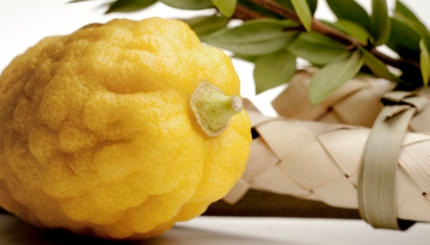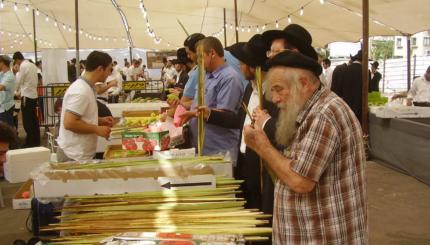After the more somber holidays of Rosh Hashanah and Yom Kippur, bursts through our doors as the Jewish holiday of unbridled happiness, z’man simhateinu (the time of our joy). Here are a few suggestions for how to make Sukkot fun for your whole family–a time to create wonderful family traditions, rituals, and memories.
Building the Sukkah
While building your own may seem like an overwhelming proposition, it can actually be a fun family project–and a relatively simple one at that. If you have the space and the inclination, consider ordering an easy, ready-to-assemble sukkah from a website such as The Sukkah Center or Sukkah Depot.
Building a sukkah is one of the few mitzvot (commandments) that involve the whole body. This can be a great bonding experience for everyone, especially in the crisp fall air. Find ways for each family member to get involved. Older children can help with the heavy building, while the younger ones can help gather tools and decorate.
If you are unable to build your own sukkah, there are plenty of opportunities to participate in the building and/or decorating of a community sukkah. Often synagogues organize family sukkah decorating events. Or you might ask a family friend who builds a sukkah if your family can lend a hand.

Help us keep Jewish knowledge accessible to millions of people around the world.
Your donation to My Jewish Learning fuels endless journeys of Jewish discovery. With your help, My Jewish Learning can continue to provide nonstop opportunities for learning, connection and growth.
Time for “Home Decorating”
The commands us to “dwell” in the sukkah. For the week of the holiday, the Sukkah becomes our home, and unlike our permanent homes–where the parents most likely do the interior decorating–Sukkot can be a fun opportunity for kids to help make decorating decisions. Your sukkah can be an ideal place to display your children’s artwork, for example.
Kids can choose a theme for the sukkah. The theme could be holiday related or not. I know one family who decided to have a “Global Sukkah” and decorated their sukkah with pictures from all over the world. Another family had a “Dora the Explorer” sukkah and made pictures of all the Dora characters. They had different parts of the sukkah represent different Dora adventure places such as Crocodile Lake and Spooky Forest.
Photographs also make great decorations, especially if you laminate them. You can take annual pictures of your family in the sukkah and then display them chronologically. This can be a wonderful way to record the growth of your family while preserving special memories of time spent together.
During the year, Sukkah decorations can be kept in a special “Sukkah Chest” to be opened only at decorating time. Over the years, your family will accumulate a unique collection of decorating memorabilia.
Dwelling in the Sukkah
Sukkot provides a wonderful opportunity for your family to “camp out” or take a vacation, right in your own backyard. During Sukkot, we are asked to feel the tension between the vulnerability of living outside in a fragile shelter and the safety of God’s protection.
Try to eat in a sukkah as often as possible. Meals can be simple, cozy and fun — just like you might have by a campfire. You can also experiment with moving some weekday activities into the sukkah, such as playdates and homework time. It is a to recite the blessing over and wave the lulav and etrog on each day of Sukkot. The mitzvah is often done in a synagogue, but the family sukkah is a great location to do it as well.
READ: How to Buy a Lulav and Etrog
Children love the coziness of being outside at night. Bedtime rituals such as storytelling and singing are even more special when moved outside with everyone snug in their PJs and extra sweaters. And if everyone feels really brave, why not bring out the sleeping bags and air mattresses and sleep in the sukkah?
(Note: Sukkot should be a time of joy and pleasure, so if the weather is too cold, or it is raining, or there is some other reason for discomfort, go back inside. Everyone should be comfortable and have fun.)
Reaching Out to Others
On Sukkot, our “home-away-from-home” can be a welcome space for guests of all ages.
Inviting family and friends (old and new) into your sukkah helps enrich the meaning of the holiday.
There is also a mystical custom on Sukkot to welcome seven biblical guests into the sukkah, called ushpizin. These biblical guests are traditionally Abraham, Isaac, Jacob, Joseph, Moses, and Aaron or David. Some families also welcome our female ancestors: Sarah, Miriam, Deborah, Hannah, Abigail, Huldah, and Esther. Ushpizin makes a great decorating theme as well. Children can draw pictures of biblical characters and stories. These stories can also be told or acted out in the sukkah, perhaps as an after-dinner activity.
Children can also think about other non-biblical ushpizin to “invite” into the sukkah. These can be famous historical figures (Jewish and non-Jewish), superheroes, and/or anyone your child looks up to.
Sukkot is a time to think about the blessing of having a permanent home, and to acknowledge that so many people lack this fortune. Families can put their thoughts into action by volunteering together a local homeless shelter or soup kitchen.
Focus on Joy
Sukkot is called z’man simhateinu, the time of our joy, and the activities, rituals, and foods you choose should focus on happiness. Sukkot is a great holiday to serve everyone’s favorite foods, wear new clothes and even exchange some presents.
In Israel and in some places in the United States, Sukkot is a week-long school vacation and thus a great time for families to go on tiyulim, or trips, together. If your family can get away, you might want to schedule an annual family hike, a trip to an amusement park, or an outing to any fun destination for this special week.
Often we tend to think that the most “important” holidays are the more serious ones, such as and Yom Kippur. Sukkot reminds us that mitzvah gedola l’hiyot b’simha, it is a great mitzvah to be happy. Hag Sameah–have a joyous holiday!



